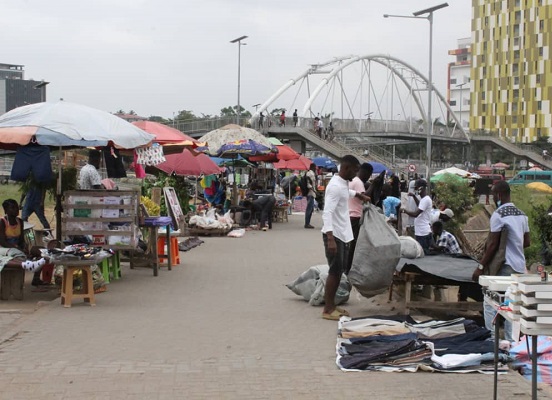In a bold move to reclaim the city’s choked walkways and restore order to public spaces, the Accra Metropolitan Assembly (AMA) and the Korle Klottey Municipal Assembly (KoKMA) have launched a joint decongestion exercise aimed at removing traders and hawkers from pavements and unauthorized areas.
The campaign being carried out with renewed zeal and a visible injection of energy, is part of a long-standing effort to enforce the byelaws that prohibit street vending in designated zones of the city.
The two assemblies have taken the unusual and commendable step of working in tandem, recognizing that tackling the perennial issue of street congestion requires more than isolated municipal efforts. This collaboration marks a significant shift from past exercises, which were often piecemeal, inconsistent, and easily reversed.
Ahead of the operation, notices were served to the traders, and awareness campaigns are being carried out to educate the public especially the traders and hawkers on the dangers of uncontrolled street trading from vehicular and pedestrian accidents to sanitation and security concerns.
Yet, despite the clear warnings and legal backing, many traders continue to resist, citing survival and economic hardship as their main reasons for occupying pavements.
“Where else can we go?” one hawker lamented. “We sell here because people walk here. If we move into shops, no one will come. We need to eat too.”
This sentiment reveals a deep-rooted motivation: proximity to foot traffic and the visibility it offers, which traders see as critical to making a living. Pedestrians, too, often find the convenience of pavement shopping irresistible, bypassing more structured commercial centers for the informal stalls lining the streets.
Historically, such exercises have played out many times in Accra, often with the same predictable cycle. Authorities clear the streets, make bold declarations, and then, slowly but surely, the traders return.
The story is the same for the Kumasi Metropolitan Assembly (KMA) that has also intensified efforts to clear hawkers and traders from pavements and unauthorized trading zones in the central business district of Ghana’s second-largest city.
Like Accra, Kumasi has long struggled with street congestion, particularly around the Kejetia Market, Adum, and other commercial hotspots where pedestrian movement is often obstructed by makeshift stalls and street hawkers.
KMA has carried out several decongestion operations over the years many of which mirror the ebb and flow seen in Accra. The most recent phase of enforcement has seen a renewed commitment by city officials, with support from security personnel and task forces, aimed at restoring order and improving mobility in the bustling metropolis.
Despite the tough measures, Kumasi faces similar challenges. Traders argue that relocating to designated market spaces results in poor sales due to lower foot traffic. “The customers are out here on the street, not inside the new market,” one vendor near Kejetia explained. This economic reality continues to undermine the effectiveness of the KMA’s efforts, no matter how frequent or forceful they are.
Moreover, just like in Accra, many residents and observers in Kumasi question the sustainability of the current campaign. Past exercises have fizzled out after a few weeks, with traders slowly trickling back onto pavements once enforcement waned. Without consistent monitoring, the provision of attractive alternative trading spaces, and region-wide coordination among adjoining municipal assemblies like Asokore Mampong and Suame, the cycle is likely to repeat.
Many citizens have come to regard these operations as "nine-day wonders", intense for a moment, but unsustainable in the long run.
Indeed, some traders are already voicing confidence that it is only a matter of time before they reclaim the pavements. “We’ll be back,” said a confident vendor near the Kwame Nkrumah Interchange. “This happens all the time. It doesn’t last.”
So, the question looms: Will this time be different?
The success of this current exercise hinges not only on the firmness of AMA and KoKMA’s enforcement but also on broader collaboration. Many observers argue that true transformation will only occur if all metropolitan, municipal, and district assemblies within the Greater Accra Region act in unison, supported by a coherent and sustained city-wide policy. Without that, the displaced traders may simply shift to nearby areas outside the jurisdiction of the enforcing assemblies, an all-too-familiar game of urban musical chairs.
There’s also the issue of alternative livelihoods and designated trading spaces. Without viable and accessible options, removing traders from pavements addresses only the symptom, not the cause.
To maintain momentum, authorities must not only enforce but also engage providing education, support for transition, and perhaps even incentives to both traders and buyers to make formal markets the preferred option.
Accra’s pavements did not become markets overnight, and reclaiming them will require more than muscle and megaphones. It will take vision, coordination, and the political will to stay the course.
The experiences in both Accra and Kumasi underscore a broader national dilemma: How do we balance the enforcement of urban order with the socio-economic realities of informal traders? Until that question is addressed with long-term urban planning and inclusive economic policies, decongestion efforts no matter how well-intentioned, risk becoming yet another temporary fix to a deeply entrenched problem.
Only time will tell whether this campaign will mark a turning point in urban management or simply add to the archive of short-lived crackdowns.
One thing is certain: Accra is watching and waiting.
By: Christian Kpesese



